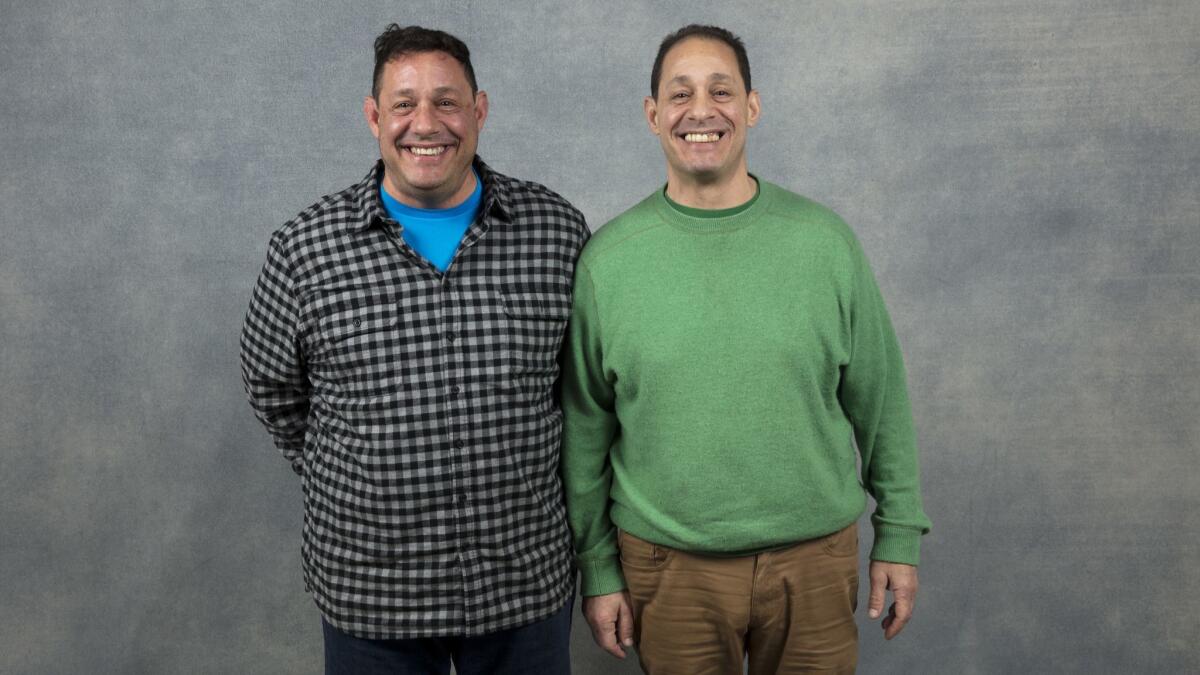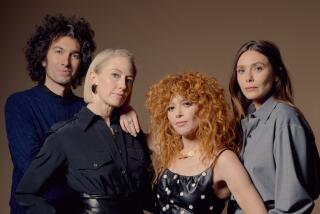‘Three Identical Strangers’ goes beyond separated triplets into the dark forces behind their story
- Share via
Unlike other documentaries that have scored at the box office this year, “Three Identical Strangers” has no singular personality to champion. No cultural icons or death-defying adventurers. What it does have comes in multiple: a phenomenal true story about identical triplet brothers, adopted by different families, who through sheer happenstance reunite as young men in 1980.
The initial feel-good vibes and celebrity status — with wild nights at Studio 54, “Today” show appearances and gossip page accounts of their exploits — subside, however. Personal traumas come to the surface, as does the revelation of the shadowy machinations that caused New York triplets Bobby Shafran, Eddy Galland and David Kellman to be separated at birth. What begins as a believe-it-or-not human interest saga sours into paranoia as a contemporary investigation shines light on a disturbing scientific experiment and its profound long-term effect on innocent lives.
For the record:
2:00 p.m. Nov. 8, 2018An earlier version of this post said the study the film’s subjects were part of was sponsored by the Jewish Board of Family and Children’s Services. It was sponsored by the Child Development Center, which later merged with the board.
“It hasn’t got any famous people,” said Tim Wardle, the British director and producer who made the film, “just the strength of the story.”
Wardle seized on the idea several years ago when a producer brought it to his attention. He was impressed not only by its “stranger than life” quality, but that there was so much more to the story left untold. Many popular documentaries, such as “Man on Wire” or “Touching the Void,” arrive with a related book already on shelves, he said. Social media also presents a problem. “There’s a diminishing pool of stories that exist in the pre-internet era,” Wardle noted. “Once the internet gets hold of a story, it’s recycled endlessly and there’s less mystery to it.”
WATCH: Video Q&A’s from this season’s hottest contenders »
As for intrigue, the filmmaker got a lot more than he could have asked for, his team resorting to a lot of shoe-leather reporting to uncover answers. Others had tried to nail down the details, he said, including major broadcast networks in the ’80s and ’90s. Each time, the reports got pulled. What Wardle’s film ultimately details are the efforts of Freudian psychoanalyst Peter Neubauer, an Austrian refugee and pioneer in the field of child psychology, to carry out a nature versus nurture study in which twins (and, in this case, triplets) placed for adoption were separated and given to families of varying socioeconomic status. The so-called “twin study,” begun in the 1960s, was lead by Neubauer, director of the Child Development Center, and aided by the now-defunct Louise Wise Services, a prominent adoption agency for Jewish children. Journalist Lawrence Wright wrote about it in a New Yorker article published in 1995, the same year that Eddy Galland, the most troubled of the reunited triplets, died.
“Wright calls it the ‘Wild West,’ ” said Wardle of a time – mostly the 1950s and ’60s – when science went rogue. “You get the Milgram Experiment, the Stanford Prison Experiment. On the other hand, the thing about adoption, it wasn’t common practice.” Decades later, the bulk of Neubauer’s research is sealed at Yale University, until 2065.
“As Larry says in the film, there are very powerful people who would rather the story not be told,” Wardle said.
In telling it nonetheless, the filmmaker created what he calls a “smorgasbord” of styles. “We really wanted to mess with genre,” he said. “It starts out almost like a John Hughes comedy, or ‘Freaky Friday,’ and then it veers off into an identity thriller. I was watching crazy things like the Jason Bourne films for it. He’s a guy who’s the result of an experiment, and the film is his quest for identity. That’s what the brothers are trying to do.”

Like all modern thrillers, the story doesn’t quite end at the end. Raw, the London-based production company where Wardle is an executive producer, has announced a feature film adaptation of the story. And recently Wardle was alerted to a new development: A 54-year-old New Jersey woman saw “Three Identical Strangers” and recognized the name of the Wise agency. A DNA test led her to her twin in Calabasas, Calif. The filmmaker was on hand to document their reunion.
“I still don’t feel that it’s finished,” said Wardle, who initiated the project six years ago, “and we picture-locked in January.”
More to Read
Sign up for The Envelope
Get exclusive awards season news, in-depth interviews and columnist Glenn Whipp’s must-read analysis straight to your inbox.
You may occasionally receive promotional content from the Los Angeles Times.






